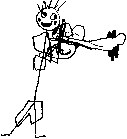

MAGICAL MUSIC



Kodàly Methods
- Music concepts experienced then taught consciously. Singing comes before reading music
- The earlier a child experiences music, song and rhyme the better
- The voice is the earliest musical instrument. You cannot sing what you cannot hear internally. If something is sung we really know it.
- Relative solfa (do, re, mi etc.) is used. It makes musical intervals memorable.
- Handsigns are used as a visual aid to express solfa. They link the sounds and the written notes.
- Notation – stick notation (designating rhythm) is used by itself at first then children read from the stave.
- English language folksongs are used initially. Rhythms from these are used when rhythmic concepts are first taught. This is because the children will feel most at ease with the rhythms of their mother tongue.
- Pentatonic music is used in the early stages. Tunes without semitones are easier to sing and the children are quickly able to achieve more satisfying and melodious results.
- 2-
part work e.g. using ostinatos, canons, independent parts etc. are used. This trains concentration, memory and awareness. It also develops the ability to listen polyphonically and powers of co- .ordination





